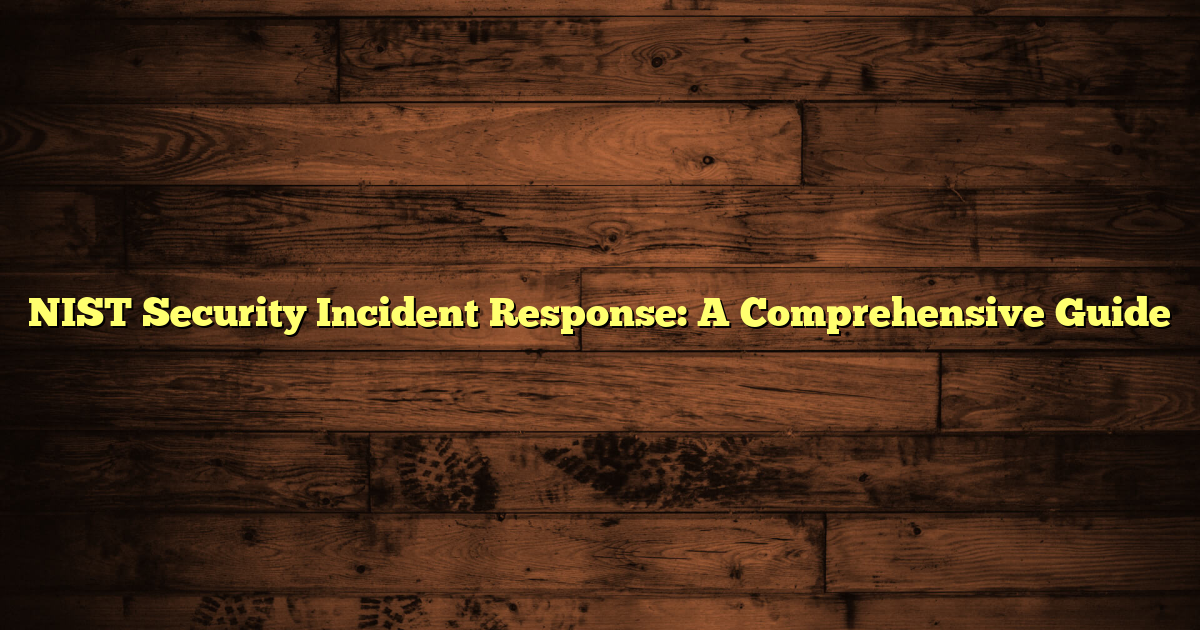NIST Security Incident Response: A Comprehensive Guide
Table of Contents:
- Introduction
- What Is NIST Security Incident Response?
- The Four Key Phases of Incident Response
- Why Does NIST Provide These Guidelines?
- Recent Updates: Expanding Beyond Four Steps
- Best Practices According to NIST
- Wrapping Up
- FAQ
NIST Security Incident Response: A Comprehensive Guide
Are you prepared to handle a cyberattack effectively? The National Institute of Standards or Technology (NIST) offers a highly regarded, commonly implemented framework for dealing with security incidents. The guidance is designed to help you prepare for cybersecurity incidents, detect them early, respond quickly, as well as recover completely. Let’s investigate what the NIST security incident response entails, its significance, next to how organizations use it to strengthen their security.
What Is NIST Security Incident Response?
At its heart, NIST’s incident response method is detailed in their publication, Computer Security Incident Handling Guide (Special Publication 800-61). This important guide offers a complete framework which breaks down the lifecycle of handling cybersecurity events into stages that are easier to deal with. The main goal is to keep the damage from attacks or breaches to a minimum, but also speed up the recovery process.
The framework is not just something you think about, it’s something you put into practice. It helps you get ready for an attack. You can do that by setting up clear roles, making people responsible, setting up ways to talk to each other, along with getting the tools that you need during an incident. When something bad does occur, such as malware getting into the system, data being stolen, or a person on the inside causing harm, then you have a plan you can follow.
The Four Key Phases of Incident Response
NIST divides the process into these four major steps:
- Preparation
This phase involves preparing everything before any problems take place. This involves teaching your workers about security, setting up systems to watch for problems, creating policies, making communication plans, putting together an incident response team with specific jobs, but also making sure you have the tools to find problems and analyze them.
- Detection & Analysis
This involves finding security events that might be happening. You do this through alerts from systems that detect intruders or through reports from your users. You have to be able to tell the difference between things that seem wrong but are not harmful and real problems that you need to take action on. That involves looking at logs, collecting proof about what happened (plus how it happened), then figuring out how serious it is.
- Containment, Eradication & Recovery
Once you determine it is an actual problem that needs action, you have to stop it from spreading. For example, you might cut off the systems that are affected. Then, you get rid of the bad elements, like malware or people who are not supposed to be there. Last, you get the system running again safely without bringing back the problems that were there before.
- Post-Incident Activity
After the situation is under control, it is time to think about what happened. Document thoroughly what happened, including the order of events and the actions you took. Hold meetings with people involved to learn from the experience. Update your policies based on what you learned, so you can respond faster and better in the future.
Why Does NIST Provide These Guidelines?
Cyber dangers are changing very fast. Ransomware attacks are getting more advanced each year, but also new exploits show up unexpectedly. So, having standard practices helps you stay one step ahead, instead of being unprepared when an attack hits.
NIST’s suggestions are a reliable guide because they come from extensive research that included government organizations but also private sector experts specializing in cybersecurity risk management. They give a shared way of talking about things, like “incident,” “response,” and “containment.” This helps teams talk clearly when they’re under stress.
Furthermore:
- They put importance on speed – responding quickly reduces the damage caused by attackers when they steal data or interrupt services.
- They stress continuous improvement – because attackers are always changing, too.
- They highlight documentation – detailed records guarantee that no step is missed next time, including compliance with rules that require audit trails after violations happen.
Recent Updates: Expanding Beyond Four Steps
In 2025, NIST shared updates that show a broader view of cyber risk management, incorporated with their Cybersecurity Framework version 2.0 community profile approach.
Now, there are six categories, in groups with preparation compared to active response phases:
- Preparation covers Governance (setting policies), Identification (knowing assets/risks), or Protection
- Response includes Detection/Analysis, as well as Responding effectively
- Recovery focuses on restoring operations safely
- Improvement emphasizes learning always from each event
This expanded model shows that finding risks early is not just part of getting ready but also ongoing improvement after things happen. That reinforces resilience over time instead of treating each event like it is its own problem.
Best Practices According to NIST
To make this framework work well in action:
- Put your team together early! Give them clear roles, like the Incident Commander, who leads, but also technical analysts who investigate alerts.
- Make playbooks that are designed for different kinds of events. That way, responders understand exactly what steps to take for different situations.
- Automate when you can, but do not depend only on technology. Human thinking is still important, particularly during the analysis.
- Test your plan regularly through simulated exercises. These “tabletop drills” show you where the holes are before real crises strike.
- Keep lines of communication open, both inside the company between IT and security teams and on the outside with law enforcement or regulators, if needed, depending on how bad the breach is.
By carefully following the rules, companies lower the amount of time they are not working because of attacks. They also protect sensitive information better than if they just made it up as they go along.
Wrapping Up
NIST’s security incident response guidance is noticeable because it balances structure with flexibility. It gives you solid foundations but also encourages tailoring based on how big your company is, what industry you are in, next to what dangers you face.
If you are running a small business worried about phishing scams, but also if you are managing large-scale infrastructure facing advanced persistent threats (APTs), you can use this framework to avoid flying blind when a cyber problem strikes. You will have proven strategies to help you contain the damage quickly and then bounce back stronger.
In today’s digital age, where cyberattacks can cost millions in lost money and reputation overnight, having blueprints you trust is not just smart, it’s necessary to continue to operate.
FAQ
What is the first step in incident response?
The first step in incident response is Preparation. This is about getting your house in order before anything bad happens. It includes training your staff, setting up monitoring systems, defining policies, along with ensuring your team is ready.
How often should we test our incident response plan?
You should test your incident response plan regularly, or at least annually, via simulated exercises. These exercises, like tabletop drills, help uncover any gaps or weaknesses in your plan before a real crisis.
What if we don’t have a dedicated security team?
Even if you don’t have a security team, you can still implement NIST guidelines. Assign incident response roles to existing IT staff, train them appropriately, or consider outsourcing to a managed security service provider.
How can I simplify NIST incident response for a small business?
Tailor the framework to your business. You should focus on the most relevant threats, prioritize critical assets, as well as create a simplified playbook with clear steps that anyone on your team can follow.
Resources & References:
- https://nvlpubs.nist.gov/nistpubs/SpecialPublications/NIST.SP.800-61r3.pdf
- https://nvlpubs.nist.gov/nistpubs/specialpublications/nist.sp.800-61r2.pdf
- https://www.exabeam.com/explainers/incident-response/nist-incident-response-4-step-process-and-critical-best-practices/
- https://github.com/tomwechsler/Ethical_Hacking_and_Penetration_Testing/blob/main/Documentation/NIST_Computer_Security_Incident_Handling_Guide.md
- https://drata.com/blog/nist-incident-response-guide





